Beschreibung des Aquariums
Besonderheiten:
Sirocco-Urne Aquarium 8 mm. Vorherige optischem Glas. Aufgedeckt. Heck-und Seitenscheiben gestrichenes Papier mit glänzend schwarz
Dekoration
Bodengrund:
Untergrund:
- Power Sand, New Amazon 5 cm Höhe an der Front.
- Rear JBL Manado um bis zu 16 cm erhöht, und mit New Amazonia
Rocks: licorella Porrera (Slate)
Aquarienpflanzen:
- Riccia fluitans
- Ceratophyllum demersum
- Microsorum pteropus
- Microsorum pteropus var. ???Narrow???
- Cryptocoryne wendtii var. ???Green???
- Cryptocoryne wendtii var. ???Brown
- Cryptocoryne pygmaea
- Cryptocoryne willisii
- Cryptocoryne parva
- Cryptocoryne costata
- Cryptocoryne nevillei
- Cryptocoryne undulata
- Cryptocoryne balansae "Red Lucanas"
- Cryptocoryne albida
- Cryptocoryne ciliata
- Cryptocoryne spiralis
- Cryptocoryne petchii
- Limnophila sessiliflora.
Weitere Einrichtung:
6 Röhren von 35 mm Gummischlauch zum Verstecken Fisch. Als Ersatz für Stein Schiefer vertikal. Insgesamt 1 Meter Schlauch.
Aquarien-Technik
Beleuchtung:
Zenith Bildschirm:
2 X OSRAM T5 Leuchtstoffröhre Tageslicht, 54 W/865
2 X Neonlicht AQUA-LIGHT 2 10 000 54 W, 10.000 ° K.
Photoperiode: 12.00 bis 00.00 Uhr Licht-Timer. Led blaues Mondlicht von 00.00 bis 08.00 Uhr.
Filtertechnik:
Filter:
- 1. EHEIM 2215, 620 l / h. Biofiltrede Keramik, 3 Schwämme und Baumwolle. Nachdem Problem mit Braunalgen: JBL Silikat Ex wird auch als Filtermaterial verwendet in diesem Sommer-
- 2. EHEIM 2215, 620 l / h. Während des Sommers und angesichts der Ungleichgewichte, die aufgetreten sind, führen wir eine zweite Filtereinheit Unterstützung. In der zweiten Einheit die Filtermaterialien sind, Keramik Biofilter und 450 Gramm Aktivkohle XUPRA. Die objecctiu reduzieren Trihalomethan Inhalte, die Vermeidung Spitzen Nitrite.
-3- Eheim Lamp UV 9 w,
Weitere Technik:
- Die Injektion von CO2 in den Kanister mit Licht Photoperiode. Die Injektion von Luft-- --Kompressor in dunklen Photoperiode
- Heizung: Eheim 319. 300 W
Weitere Einrichtungen au??erhalb des Aquarium:
- Water Purifer compact Ro Unit
- Präzisionswaage
- 5-Liter-Glasrohr mit einem Kompressor und Diffusor Stein für den Anbau von Artemia
Besatz
Colisa chuna 2
Danio margaritatus 24
Borara merah 21
Botia striata 5
Botia kubotai 10
Pangio khulii 10
Wasserwerte
GH: 10
KH: 4
PH: 6, 5-6, 8
NO3: 5 mg / l
PO4: 0, 2 mg / l
K: 35 mg/l
Fe: 0.10-0, 25 mg/l
25 ° C
Futter
1. Frozen food: Blood worms, Ocean Nutrition
2. Dry food: Spirulina, Sera
3. Dry Food: Tropical wafers, Ocean Nutricion
4. Frozen food: Brine Shrimp, Ocean Nutricion
5. Dry Food: Gammarus, Dajana
6. Live food: nauplii of artemia
7. Live food: Snails, Planorvis tuberculata
8. Feed plant 1: peas, chard, garlic, carrot, lettuce and gelatine, preserved frozen
9. Dry food: Tubifex cubes, JBL
10. Dry Food: Atyson Betta started, Ocean Nutrition
11. Dry Food: Blood worms, Sera
12. Lettuce
13. Dry food: Sera Vipan
Monday: 13, 12, 9
Tuesday: 13, 6, 8, 5
Wednesday: 6, 8, 11
Thursday: 13, 2, 4
Friday: 10, 8, 7
Saturday: 13, 2, 1
Sunday: 10, 8, 3
Kultivierung von Artemia-Nauplien Verdünnen mit 28 g Kochsalz ohne Jod in 1 Liter Wasser, sondern mit Luft Kompressor. Fügen Sie Eier Artemia Ozean Nutricon. Die Eier brüten in 48 Stunden.
Wachsende Schnecken planorvis: in 5 Liter frisches Wasser, mit Lymnophyla, Lectuca sativa und einem Schwamm Filter.
Videos
Sonstiges
25% Wasser wechselt wöchentlich
Der Wasseraustausch, ca. 70% Wasser Heimnetzwerk, 30% Wasser Osmose
Wasserverdunstung: 100% zugesetztem Wasser Osmose
Chlor wird eliminiert: Na2S2O3, Verdünnung 100 g / l. Ein Tropfen entfernt Chlor Verdünnung auf 1 Liter Wasser.
....
CO2-Blasen 100 Minuten für 10 Stunden täglich
....
Tests für die Wasseranalytik:
- NO3, PO4, pH 6-7.6 de JBL, K de Salifert, Fe de Tetra (2 mal pro Woche)
- Sera Gh, Kh von Prodac (nach Wasserwechsel). Sera Mg (gelegentlich)
- Analytische gelegentlich nach der Medikation: NT Labs Nitrit, NH4 Aqua; Salifert Cu.
.......
- Chemische Verbindungen: Kaliumnitrat (KNO3) für befruchten, Kaliumsulfat (K2SO4) für befruchten, Casement Verdünnungen Enema (Mononatriumphosphat NaH2PO4) / Monokaliumphosphat (KH2PO4) für befruchten, Natriumthiosulfat (Na2SO2) zum Entfernen von Chlor aus dem Wasser, Kaliumcarbonat (K2CO3) für Korrekturen von Kh , Magnesium-Sulfat (MgSO4) für Korrekturen von Gh, Calciumsulfat (CaSO4) für Korrekturen von Gh
------
Organics:
- Leaf Quercus faginea (gesammelt Montsec)
- Alder Kegel (gesammelt in den Ufern des Flusses Nogera Ribagorçana)
- Flourish Excel 7.5 mL Tage
.........
Verbrauch schätzt macrofertilitzants Tag:
Kaliumnitrat (56 Gramm / Liter): 30 ml Tage
Kaliumsulfat (56 auflösung Gramm / Liter): 10 ml Tage
Casen Enema (verdünnt auf 2%): 15 ml Tag.
Micros:
Ferropol alternative Hortrilon alle 10 Tage. 1/2 Dosen
...............
Arzneimittel (so far):
. 1 Behandlung mit Erythromycin (gegen columnaris)
- 1 Behandlung mit Malachitgrün (gegen ichthyo)
- 1 äu??erliche Behandlung mit Kupfersulfat für Algen schweren Angriff
Filterung mit Aktivkohle nach der Medikation.
Infos zu den Updates
10/01/2013: placement of gravel and solid
18/01/2013: Initially planted
25/01/2013 Ammonia downward, peak nitrite
...
17/06/2013 Adaptation of the aquarium to the recommendations: Strong thinning of cryptocorines, removal of the right vertical flat slate. After thinning cryptocorines, there???s an area of pasture plants for different botias taking advantage later for the installation of traps, withdrawal of 4 Crossochelius and 1 Gyroncheilus
27/06/2013 Replacement of a lamp Neonlicht AQUA-LIGHT 2 10 000 54 W, 10.000 ° K., for F54T5/830 Sylvania 54W 3000K T5 48 Linear Fluorescent Tube Lamp, in the back. I maintained on one of the 10000 K lamps, in the front (where Riccia, planted in the front at the end is more abundant.) the water column is here about 45 cm, and the blue light with shorter wavelength has a better penetration. According to the developments , I will consider substituting the other 10000 Klamp. The traps have worked, I captured 3 Gyrinocheilus aymonieri. I am implementing the dietary changes. I have grown brine shrimp and snails (Planorvis tuberculata). Plant feed is made with peas, chard, garlic, carrot, lettuce and gelatine, preserved frozen-
06/07/2013 I captured all the Crossocheilus. But I don???t know if it???s due to the changes in the light spectrum, or the changes in the flora and fauna, the aquarium is now imbalanced.
: (
1. Ichthyophthirius attack on Iriaterina, which has been successfully treated with Malachite Green. And then I cleaned the Malachite Green with an activated carbon filtration. All the other fish species seem to have liked the changes, better coloring and activity.
2. Proliferation of brown algae on the leaves of Microsorum and Cryptocorynes. The analytical shows that the daily needs of phosphates have doubled, even after 3 days after the removal of the activated carbon filter. Suggestions to address this problem are welcomed. My intention is to extend photoperiod for two hours, increase the doses of CO2, and correct the phosphate deficits. (In short, make plants do the work!) I'll check if there is an imbalance Ca / Mg
21/07/2013. Algae persist. Working hard to control brown algae:
1. Extending the photoperiod to 12 hours
2. Daily control of the parameters of water and fertilizer correction
3. Water Changes: 80% RO water, 20% water from the house network. Subsequently kH measurement and adjustment to a value of 4 with calcium carbonate and up to 12 gH with magnesium sulfate
4. Incorporation of fast-growing plants (Ceratophyllum demersum in surface)
5. Increase of CO2 concentration
6. Riccia fluitans have problems with copper sulfate. I extract the anchor stones to clean and maintained the Riccia at surface.
7. Clean filter and aquarium walls
8.Microsorum is plated with copper sulfate dilution outside the aquarium
9. Fertilization of Cryptocorynes with pills background with Crypto TetraPlant
Finally, and much to my regret, I decide to skip one of the recommendations made: Change the fish populations of the aquarium, reintroduction of the 5 Crossocheilus, and addition of 5 more Crossocheilus.
I make this decision because the aquarium does not have any algae consumer, invertebrates are incompatible with botias, 90% of the fitomasse is slow growth.. Under these conditions, any algae attack can become a serious problem for my plants.
After checking the morphological characteristics of these fish, (http://www.seriouslyfish.com/species/search/crossocheilus) 2 of the older fish specimens appear to correspond to Crossocheilus atrilimes, while others have a size much greater. The new 5 Crossocheilus purchased were chosen considering that their characteristics, individuals without visible barbels. Crossocheilus seem atrilimes, but I'm not sure, we will see how they grow.
Take to complete the purchase, Botia striata populations.
The tank overpopulation is solved with moving Iriatherina werneri and Pseudomugil gertrudae in a other aquarium.
27/07/2013 Brown algae persist, in the morning the infestation is high:
- Remove floating plants to give more light to the bottom of the aquarium.
- Treatment with glutaraldehyde (triple dose)
- Microsorum cleaning with chlorinated water to the outside of the aquarium Pruning of affected leaves
- Installation of the filter JBL SilicatEx
At night, the improvement is obvious, I hope to evolve well
29/07/2013 Third day without appreciating a significant increase in the population of algae, the situation begins to be controlled
04/08/2013 The algae are still under control. Pruning Lymnophyla. Reintroduction of Riccia fluitans
14/08/2013 after fertilization, a new blossoming of brown algae/.
15/08/2013 Reset!!! removal of rocks, disinfection of solids, disinfection Microsorum, replanted, withdrawal crossocheilus siamensis (3)
adequacy of the tank for Botias:
- Sandy area
- Less angular stones are selected and leave the bottom flat
- Riccia leaving only in surface
- Selection new plants cryptocorynes with harder leaves :. C ciliata, C. spiralis, C petchii.
- Installed. The second filter, with ceramic tubes to prevent an increase in nitrited, and give more movement in the water
Currently the plant is quite chaotic!
20/08/2013 The possibility that brown algae outbreaks are related to organic materials from the water of the water network. In Spain chlorine used to purify water. Activated carbon is incorporated in a second filtering unit, mainly to reduce trihalomethanes. If this was the cause of brown algae no point maintaining a high population of both Crossocheilus. Not sure if this will be enough to solve the problem, because you could have all the contaminated substrate of the aquarium. But before changing the gravel I hope if I can solve the problem.
The intention is to maintain the activated carbon filter with ANTICHLORINE adding up to disappear completely brown algae. The other option would be to replace the clay substrate, which is the transplantation of all Cryptocorines, I will try to avoid
22/9/2013 Now brown algae, solely I come to the glass, just on the base of the substrate, but not put on the plants that have recovered well. It returns to the original radiation, with two fluorescent 10, 000 K instead of 830/10000. I need short-wave light to keep Riccia fluitans to the bottom of the aquarium as upholstery. Large Cryptos and plants flotans, they shaded the fish. With the change of radiation there was a peak unicelulars-green algae has been incorporated UV lamp, and two days the water has been completely transparent.







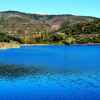
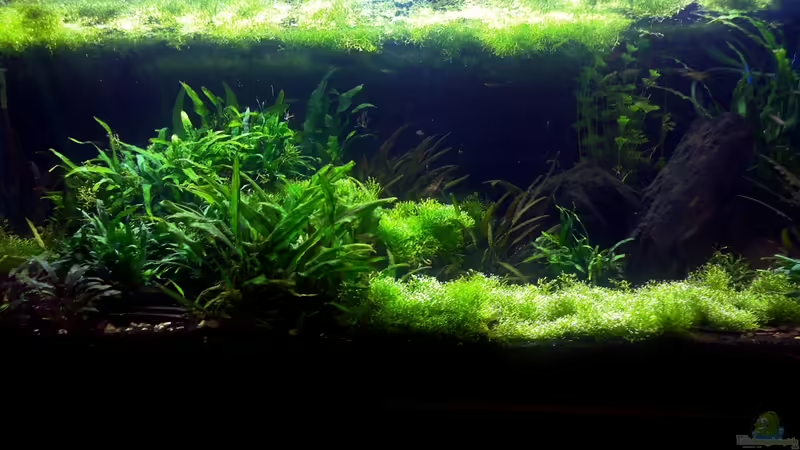






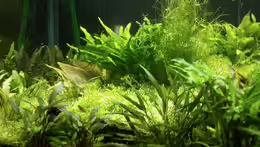

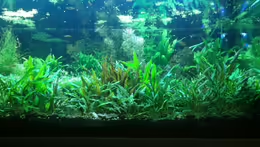
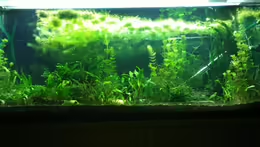

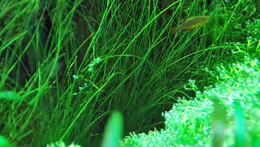














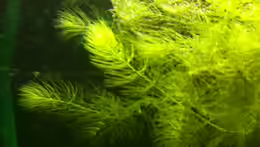

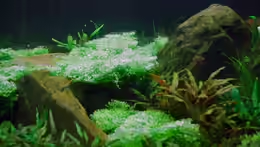



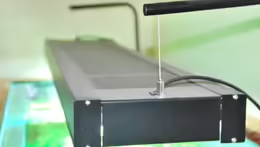
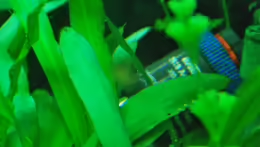
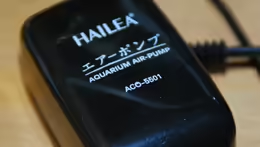
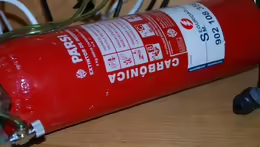













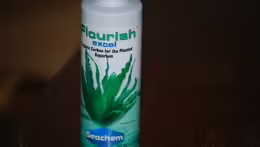

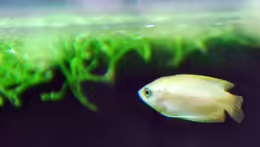
















User-Kommentare
Buenos Diaz
Un hermoso acuario, y un muy buen trabajo.
Le deseo todo lo mejor con esta cuenca continúa!
Saludos, Falk
Hi,
nice Tank but i prefer the look with not sooooo much plants because the stones look very great!!
Greats Patrick